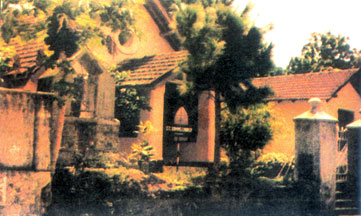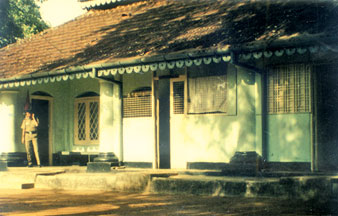Rakwana in old British colonial days
by Gamini G. Punchihewa
|

A part of the Arannaya forest in its pristine state
|
In those halcyon days of the British Raj when British planters of
Rakwana held sway in their stately plantation mansions they inevitably
had their stables there. Those were the grand old days of horse
carriages. What remains of those stables can still be seen at Rakwana.
The roadway was then motorable only up to the picturesque Bulutota
pass via Rakwana-Pelmadulla, Madampe junction and finally to Ratnapura-Colombo
bound.
The majestic Rakwana massif part of the Sinharaja tropical rain
forest rises out of this forest cover.
The horse carriage terminus was at Rakwana where stables were built.
Those grand stables to house horses and the carriages were built in
splendid architectural style. Quite pleasing and imposing.
These stables were built of brick and mortar. Its roof was covered
with calicut tiles. The architecture being of Kandyan style, the roof
carries with it on its top a vaulted roof with calicut tiles. Wooden
finials adorned the roofs and its sides. It also had a blend of the
British architectural touch as well adorning the corners of the titled
roof.
The Rakwana stables had four compartments to shelter the horses and
carriages. The Calicut tiles are dated as 1862. Hence these old stables
could be over 100 years old.
Today those stables house the Rakwana police station. Nevertheless,
its aesthetic and antique appearance is evident.
One alteration has been that the four compartments have been
converted into four apartments by separate walls to accommodate the
police cells, public entrance, armoury, stores and OIC's office. Its
window panels are also trellises.

On a small hillock the little Baptist Church built by the
British planters in the Rakwana town in 1887 |

The Police station Rakwana housed in the old stables coming down
from British and Maduwanwela Dissawa's times |

The renovated Bulutota Circuit Bungalow. |
It is perched on a hillock having a commanding view of the fine
mountain scape filled with hills and cascading water falls. Galdola Ella
overlooks the Rakwana town.
"Handbook for the Ceylon Traveller" published by 'Studio Times' -
Nihal Fernando gives a vivid but fascinating account of this wondrous
Bulutota Pass.
"The Bulutota Pass, climbing upward in 10 hairpin bends from Rakwana
(11 mls. buses) presents a magical change of view: before the summit,
mainly to the North, the Tanjantenna Plateau backed by the Sleeping
Warrior ranges and queened over by Adam's Peak; once through the summit
cutting, and the view looks southward over the jungle plains towards
Kataragama, Hambantota and the silver-flashing sea. The circuit bungalow
commands much of both views.
Immediately above the bungalow and some 1,500 ft. above it lie the
Handapana Ella Plains (surrounded by the virgin Sinharaja rainforest)
perhaps the most sequestered portion of the whole island and accessible
only by a strenuous, pathless scramble."
Rakwana is quiet accessible easily along the main Colombo-Ratnapura-Pelmadulla-Embilipitiya-Nonagama
junction. It is 94 miles from Colombo. The turn off is via Madampe
junction to Rakwana/Deniyaya. From Embilipitiya where we have been
staying for over forty years, the distance is about thirty miles.
The other older colonial buildings in the same premises where the old
stables are located, are the circuit bungalow of the famed Maduwanwela
Dissawa (popularly then Dissawa was called Kalu Kumaraya - Black
Prince). A romantic story revolves around an amusing and heroic incident
that occurred between him and two German princes. On seeing the Dissawa
the arrogant German princes ordered the coach driver with the insolent
words, "Don't allow that black bastard to get into the coach, as we are
two princes from Germany." In frothing anger he blurted out, "You may be
princes, but I am the Black Prince of Ceylon and immediately he ordered
the coachman to throw them out of the coach when, they had to eat the
humble pie and go by bullockcart to Ratnapura. Over this dauntless act
of the Dissawa, he came to be known as Black Prince or Kalu Kumaraya.
The Dissawa is still held in legend as a fearless warrior who never
bowed down to the white sahibs.
When the Dissawa came to Rakwana he occupied the circuit bungalow for
his official work. This old fabric of a circuit bungalow that Dissawa
had occupied has been much altered. Its roof tiled with calicut tiles is
gone.
Instead it is replaced with asbestos sheets. Some parts of the
original building complex, both exteriors remain unchanged.
The building on its left flank juts into a small verandah with glass
panes with shutters. The doorway is on a side with a glass pane door.
The kitchen is adjoining the front verandah.
The part of the building which is still of interest is the floor
which is studded with myriad pieces of porcelain. the floral decoration
are in the form of a huge lotus flower in full bloom. There are empty
grooves which were embedded with gold sovereigns and gems. Engraved on
the studded floor is 15.08.1897,
This Maduwanwela's antiquated circuit bungalow is now used as the
police quarters of Rakwana police station. In the Maduwanwela Walauwe in
the Kolonne Valley, the floor space of the verandah is studded with such
exquisite pieces of crockery in the form of a lotus flower in bloom.
Its date there is marked as 01.01.1901, thereby indicating that the
Dissawa's circuit bungalow at Rakwana is just four years older than the
spacious Maduwanwela Walauwa in Kolonne.
Adjoining the police station on the same elevation, lies the Court
House where the Maduwanwela Dissawa dispensed justice with an iron fist.
This sprawling building is largely changed today with the roof being
replaced with asbestos sheets. The front windows are glass panelled. At
present this building is used as the Court House where sessions are
held.
Here lies, by the roadside a small but beautiful church named St.
John's Church which is over 100 years old. On its outer wall is carved
the year 1887 prominently. So this, it is undoubtedly the oldest
building in Rakwana as the Maduwanwela's bungalow was built in 1897 -
ten years later. The church, unique in design and architecture has a
timbered gable in its frontage porch. Its porch of brick and plaster
appears to have been built in 1902 as indicated on it. On a tablet
displayed at its entrance are inscribed the following lines:
"This church dedicated to St. John the Baptist, was built in 1887 by
the Church Missionary Society, London. It is maintained by the alms and
free will offerings of her worshippers. Behind the Christian giving,
discern and the good hand of the God and we would ascribe all the praise
to Him who disposes the hearts of his children to give liberally of
their means for the work and witness of this church. The church, Hony.
Treasurer would be pleased to receive contributions from visitors and
worshippers.'"
The original patrons of this small church had been the British
planters. The Church is still held in reverence and patronized by the
local Christian community. Adjoining this little church is a small
graveyard. The Vicarage adjoining the church appears to be as ancient as
this church. There is a Vicar in residence there. The little belfry
stands on a dwarf stone masonry pedestal.
Its retaining wall comprises stone masonry work. Another old Colonial
building is the hospital. Its tiles are dated 1862. Despite subsequent
extensions, the old buildings still remain intact in its pristine state.
Close to this little church lies yet another colonial relic - the
post office. its roof is clad with calicut tiles having a vaulted roof
over it. This antiquated building housing the Post Office is nearly 75
years old.
The other landmark of great antiquity and beauty with a scenic
mountain setting is the colonial type Rest House perched on a hillock by
the road side of the Suriyakanda Road within easy reach of the Rakwana
townlet. The verandah projects into its square frontage having
cloistered glass shutters. It occupies a spacious area covering its
three sides.
This Rest House in the days of the planters and the stage coach was
where the Planters, Dissawas, Government Agents, Rate Mahatmayas and
other high officials of the colonial regime relaxed, dined and wined. It
is still patronised by tourists - local and foreign.
The Galdola Ella flowing from the surrounding mountains could be
viewed from this Rest House. It still brings back to mind the unspoilt
memories of the life and times of those stately bygone days. |

